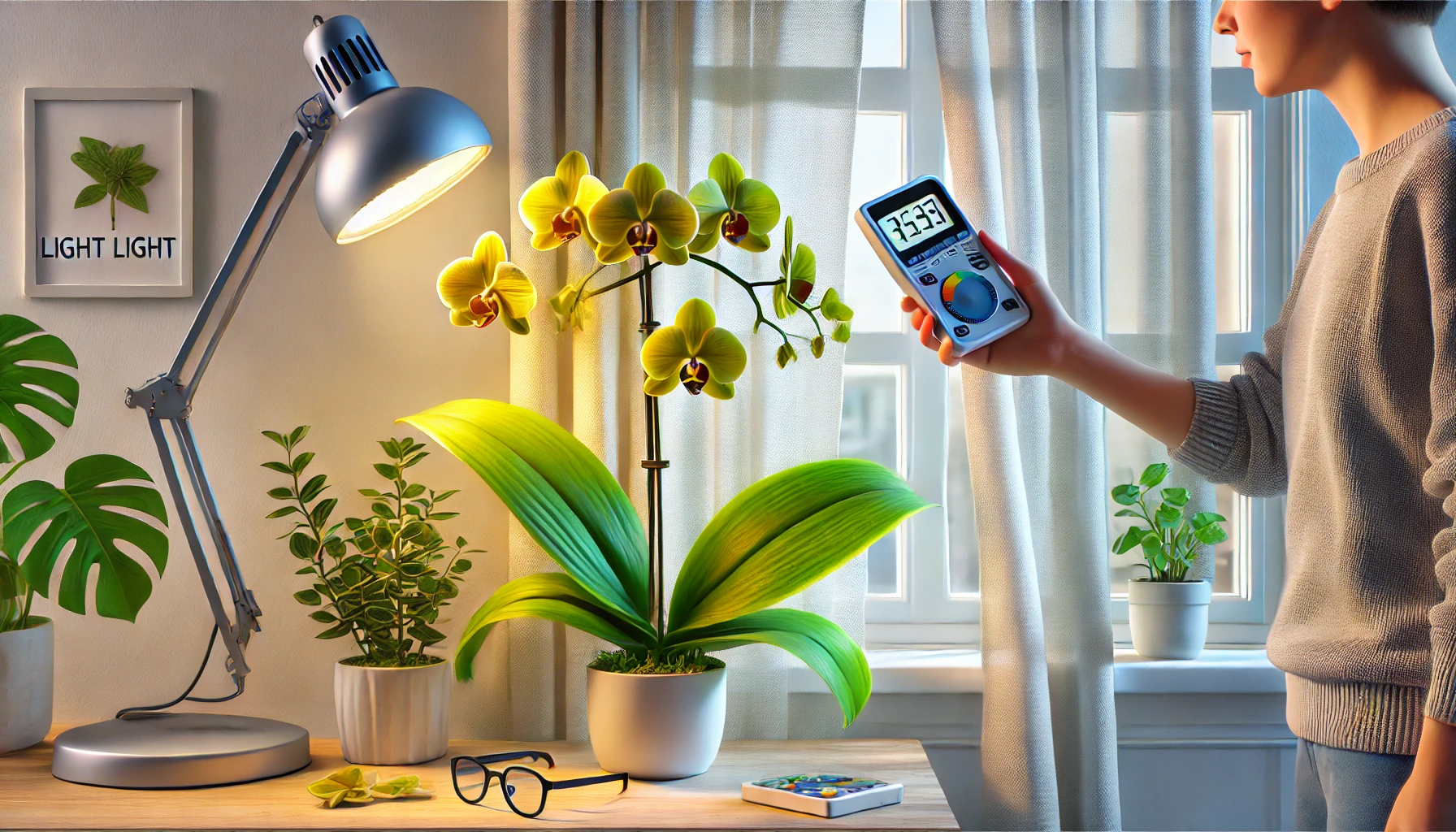Light is one of the most important factors in orchid care, directly affecting growth, leaf health, and blooming. Many orchid owners struggle to find the perfect balance—too much light can cause leaf burn, while too little light can prevent flowering. Understanding how to recognize the signs of light stress will help you adjust your orchid’s placement and ensure it thrives.
🌱 Why Light is Essential for Orchids
Orchids use light for photosynthesis, the process that converts sunlight into energy for growth and flowering. Different species have unique light requirements, but most orchids prefer bright, indirect light. Insufficient light can lead to weak leaves and no flowers, while excessive light can cause leaf damage.
✔ How Light Affects Orchids:
- Provides energy for root, leaf, and flower development.
- Stimulates flower spike growth, especially in Phalaenopsis and Cattleya orchids.
- Prevents leggy, weak growth caused by low light.
- Protects leaves from sunburn caused by excessive direct sunlight.
💡 Adjusting your orchid’s light exposure is one of the easiest ways to improve its health and encourage blooming.
☀️ Signs That Your Orchid is Getting Too Much Light
Orchids that receive too much light can become stressed, leading to burned leaves, dehydration, and stunted growth.
✔ Common Symptoms of Too Much Light:
- Yellowing or reddish leaves – Too much direct sun causes chlorophyll breakdown.
- Brown or black sunburn spots – Irregular patches of damage appear on exposed leaves.
- Thick, leathery leaves – The plant produces thicker leaves as a defense against light stress.
- Dry or curling leaf edges – Excess heat and light cause water loss.
💡 Sunburned leaves will not recover, so it’s important to move the orchid to a shadier spot before more damage occurs.
✔ How to Fix It:
- Move the orchid to an area with filtered light (such as behind a sheer curtain).
- Reduce exposure to direct sunlight, especially during midday (10 AM–4 PM).
- Increase humidity and air circulation to prevent leaf dehydration.
- If growing outdoors, place orchids in partial shade under a tree or pergola.
💡 Orchids that prefer bright light, like Cattleya or Vanda, should still avoid direct midday sun.
🌑 Signs That Your Orchid is Getting Too Little Light
If an orchid does not receive enough light, it may survive but will struggle to bloom and grow properly.
✔ Common Symptoms of Too Little Light:
- Dark green leaves – The orchid produces more chlorophyll to compensate for low light.
- No flower spikes – Lack of light prevents blooming, even in healthy plants.
- Slow or weak growth – Leaves and roots may develop more slowly.
- Leggy appearance – The plant may stretch toward the nearest light source.
💡 If your orchid has healthy leaves but hasn’t bloomed in over a year, low light is likely the cause.
✔ How to Fix It:
- Move the orchid to a brighter location with indirect sunlight.
- Use a grow light if natural light is insufficient (10–12 hours daily).
- Rotate the orchid occasionally to ensure even light exposure.
- Choose an east-facing or south-facing window with filtered sunlight.
💡 Phalaenopsis and Paphiopedilum orchids tolerate lower light, while Cattleya, Vanda, and Dendrobium need higher light levels.
🌞 How to Find the Perfect Light Balance for Orchids
To determine if your orchid is getting the right amount of light, check its leaf color and growth habits.
✔ Healthy Light Exposure:
- Leaves are light to medium green.
- New leaves grow at a steady rate.
- The orchid produces flower spikes at least once a year.
✔ Best Window Placements for Orchids:
- East-facing window – Ideal for most orchids, providing gentle morning sunlight.
- South-facing window – Good for high-light orchids if sunlight is filtered with sheer curtains.
- North-facing window – Suitable for low-light orchids like Phalaenopsis.
- West-facing window – May be too intense in the afternoon but works with some shading.
💡 If you don’t have enough natural light, consider using an LED grow light to supplement.
💡 Test Your Orchid’s Light with the Hand Shadow Method
A simple way to check light levels is by using your hand to cast a shadow near the orchid:
✔ Bright Light: Sharp, well-defined shadow = Too much direct sun.
✔ Medium Light: Soft shadow with blurry edges = Ideal orchid light.
✔ Low Light: No shadow or very faint shadow = Not enough light for blooming.
🚫 Common Mistakes When Adjusting Orchid Light Exposure
❌ Moving orchids too suddenly – A drastic change in light can stress the plant. Adjust gradually over a few days.
❌ Leaving orchids in constant low light – Without enough light, flowering is unlikely.
❌ Placing orchids too close to grow lights – LED grow lights should be positioned at least 12 inches away.
❌ Ignoring leaf color changes – Dark green leaves indicate too little light, while yellowing may mean too much.
🛡 Final Tips for Ensuring Your Orchid Gets the Right Light
✔ Observe leaf color—medium green leaves indicate good light exposure.
✔ Adjust placement gradually to avoid stress from sudden light changes.
✔ Use sheer curtains to filter intense sunlight and prevent sunburn.
✔ If blooming is an issue, increase light exposure slightly.
✔ If natural light is insufficient, supplement with a full-spectrum grow light.
By finding the right balance of light, your orchid will grow strong, stay healthy, and bloom regularly, bringing beauty to your home year after year! 🌸✨
